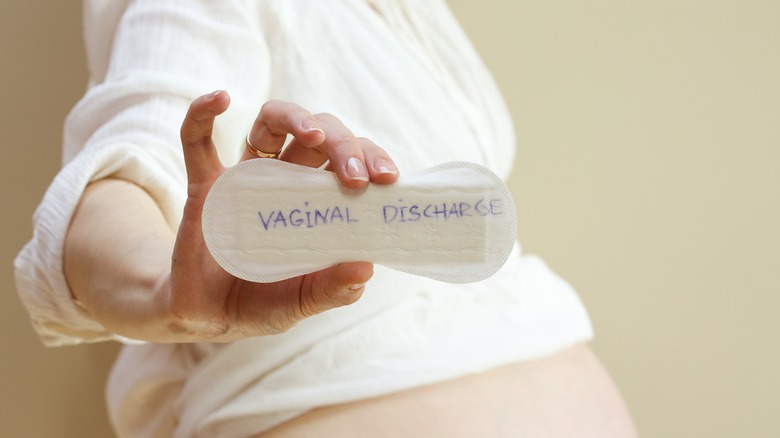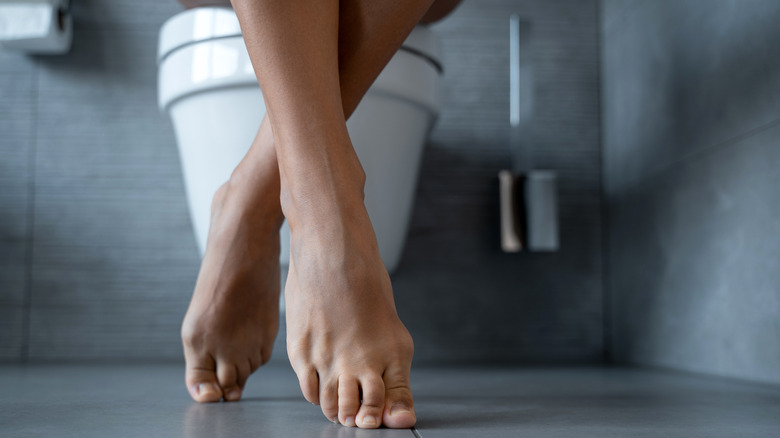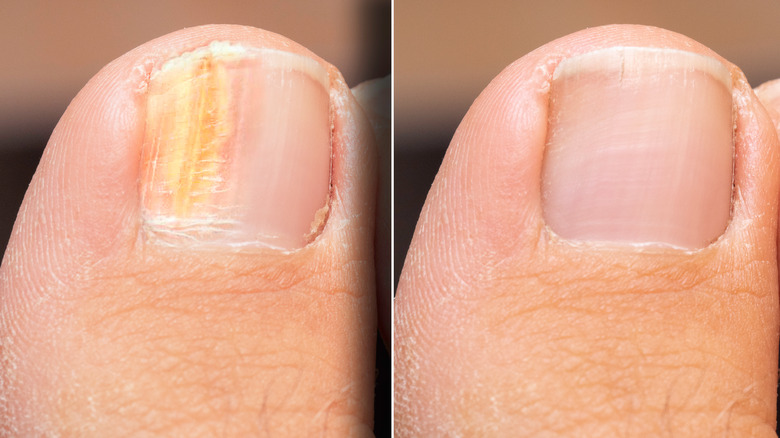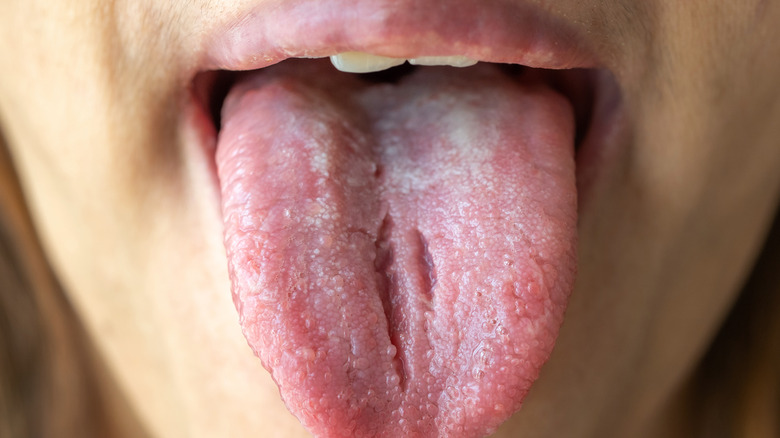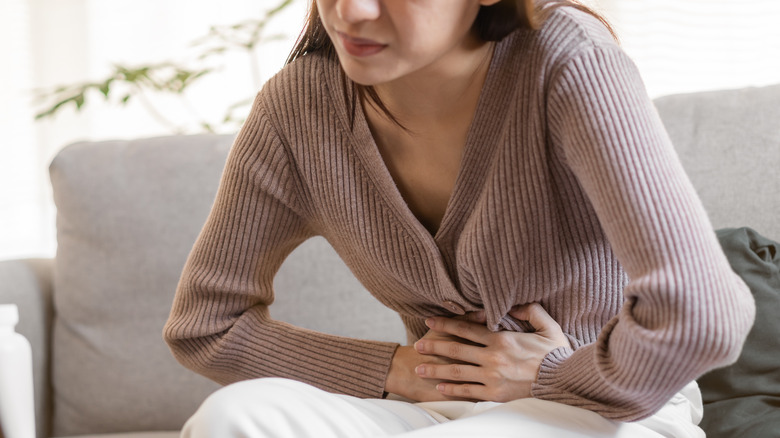What Really Happens To Your Body When You Get A Yeast Infection
There is no way around the fact that a yeast infection is super annoying, to say the least. Between the incessant itching, inflamed skin, and — if it's a vaginal yeast infection — the change in discharge and burning sensation when you urinate (per the Mayo Clinic), it can literally feel like it runs your entire life until you're able to find some relief (either via an over-the-counter cream like Monistat or an oral antibiotic like Diflucan, via WebMD).
Yet, did you know that yeast is a type of fungus that you already have throughout your body? The technical name for it is candida, and usually your immunity helps keep it under control. However, when your immune system isn't as strong as it should be, yeast can overtake the "good bacteria" in your body and cause an infection — not just in your vaginal region either. It's not uncommon for some people to get a yeast infection in their mouth (it's called "oral thrush"), on their nails, or pretty much any area where folds of skin can trap in moisture for yeast to thrive.
Let's look at some things that happen to your body when you get a yeast infection. That way, you'll know more about how to spot this type of illness, when to see a doctor, and what you can do, from home, to try and prevent a yeast infection from coming on — or coming back.
You probably experience incessant itching in your genital region
Since vaginal yeast infections are pretty common (approximately a million women experience at least one every year), let's start with those. Candida mostly lives in your mouth, gut, and vagina — that's why so many of them occur in your vagina. Fluctuating hormones, diabetes, a weak immune system, antibiotic use, and stress are the most common causes of vaginal yeast infections.
According to Healthline, what makes the itching so bothersome is the natural presence of good bacteria and yeast inside of the vagina. However, when the yeast multiplies to the point where it overcomes the amount of healthy bacteria present, an infection transpires, of which a lot of itching may take place.
While it can be tempting to scratch, try and avoid scratching at all costs. Not only could it spread the infection, but it could also cause slight tears to your vulva (the outer part of your vagina) — this could make the infection even worse, as Planned Parenthood notes.
Also, because conditions like bacterial vaginosis, contact dermatitis, and even pubic lice can create similar itching sensations, if you've never been diagnosed with a yeast infection before, see a doctor (via Healthline). You don't want to waste money on an over-the-counter medication that may not work because you're trying to treat the wrong thing.
You'll probably notice a change in vaginal discharge
A healthy vagina is going to have discharge. Verywell Health shares that it's typically thin and clear or slightly milky in appearance. The glands in your vagina and around your cervix help to produce this fluid so your vagina can stay lubricated and to fully flush out old cells. Leading up to ovulation, you may experience more discharge — following ovulation, you may notice less. What should not be the case, though, is seeing a lot of thick, white, and clumpy discharge. If that is the case, you could have a yeast infection (via Healthline).
The main thing to keep in mind is that discharge associated with a yeast infection doesn't tend to have a fishy odor, and it isn't yellow, green, or gray in its appearance. If that is what you're noticing, there's a chance you may have bacterial vaginosis (BV) or some other type of infection. And that is just one more reason to make an appointment with your physician as soon as possible.
You can experience burning when you urinate
Healthline shares that, because a yeast infection can cause inflamed skin tissue and scratching, it's not uncommon to feel a burning sensation when you urinate. However, since this can also happen when you've got a urinary tract infection (UTI), how can you tell the difference between the two?
That's a really good question. When you have a yeast infection, you may experience burning when you use the bathroom and when you have sex. When you have a UTI, not only does burning tend to happen, but you also have a constant urge to urinate (even if nothing really comes out). Plus, your urine may be cloudy (or have a tinge of pink or red in it) and might smell unpleasant. These symptoms aren't typically associated with a yeast infection, according to Healthline.
If, for some reason, you're still not sure which one you have, there are at-home UTI tests you can take (per WebMD). Just know that you should still probably see a doctor, even if you end up ruling one or the other infection out.
Your nails could get fungal infections
Now that we've touched on some of the symptoms that come with having a vaginal yeast infection, let's look at some of the ways that yeast infections can show up in the body. For instance, did you know that a lot of nail fungal infections are yeast infections, too? According to the Mayo Clinic, when this happens, your nails are usually thicker, a darker color, and might have a slight odor.
The Mayo Clinic shares that this type of yeast infection can happen to anyone at any age, although it's more common in older individuals who may have dry and brittle nails. People who are most susceptible are those who sweat a lot, walk barefoot in common areas (such as public gyms and pools), or have a skin condition like psoriasis.
It should also go on record that a yeast infection on your nails that goes untreated could result in some level of permanent damage to your nails. That's why it's important to keep your hands (and feet) clean. You should also wear socks that absorb sweat, wear flip-flops or sandals in public places, and, if you regularly go to nail salons, make sure they sanitize their tools beforehand.
You could find white patches inside your mouth
Another kind of yeast infection is oral thrush. It's what happens when the infection occurs in your mouth. This type of candida is usually Candida albicans, which is similar to that of a vaginal yeast infection. However, it's important to note that the fungus is already in your mouth and that infection transpires from some type of overgrowth (via the Mayo Clinic).
Anyone can be diagnosed with oral thrush, but babies and older people deal with it the most (since their immune systems tend to be more fragile). That said, if you happen to notice white and/or raised lesions in your mouth, redness and/or cracking at the corners of your mouth, sores that have a burning sensation, or a loss of taste — or if your mouth feels like it's full of cotton balls — definitely see your doctor.
If you're curious about what you can do to prevent oral thrush, keep these things in mind: brush your teeth twice a day, see your dentist annually, and treat a vaginal (or penile, per Healthline) yeast infection before participating in oral sex (so that the infection doesn't get passed back and forth).
You could get a yeast infection on your breasts
Remember when we stated that yeast infections can also pop up on folds of skin? This is why some women have gotten this type of infection either on or underneath their breasts. According to Healthline, it can happen when a mom is nursing a newborn because, if her baby has oral thrush and her nipples happen to be dry and cracked, the yeast can enter into her system that way. If this is the case, her nipples may look shiny and/or flaky and will feel itchy and irritated.
Verywell Health shares that a yeast infection can also happen underneath breasts because this is an area that can easily trap moisture for long periods of time, resulting in a possible rash — you might experience itchiness, discoloration, and, possibly, even oozing blisters.
When it comes to yeast infections of the breasts, Verywell Health explains, keep in mind that, if you're a new mom and you sense that your baby may have oral thrush, get it checked out immediately. As for a yeast infection underneath your breasts, try to watch your weight, avoid wearing bras that don't fit (and don't raise your breasts up above the skin beneath them), and do your best to ventilate that part of your body as much as you possibly can. The more that skin can "breathe," the less moisture there will be for yeast in which to thrive.
You may feel extremely fatigued
Now that we've talked about different areas of the body where yeast infections are prevalent, let's look into some of the symptoms that are pretty common with them all. One is fatigue. In fact, Healthline states that feeling drained is probably the most common symptom associated with having a yeast infection. A main reason why is that a candida overgrowth usually goes hand-in-hand with not only weakened immunity but also some type of nutritional deficiency. For instance, when your system doesn't have an adequate amount of magnesium, Vitamin B6, and fatty acids, you can feel run down. Then, when the infection takes over, this can drain you even more.
That's why it's important to note another proactive approach to keeping yeast infections at bay: taking a multivitamin and eating foods full of these nutrients. Magnesium-rich foods include almonds, raisins, beef, broccoli, and bananas. Foods filled with Vitamin B6 include dark leafy greens, cantaloupe, tuna, chickpeas, and fortified cereals. Foods that contain lots of fatty acids include fish, avocados, virgin olive oil, walnuts, and chia seeds (per WebMD).
You might experience digestive issues
Did you know that somewhere between 70 to 80% of your immune cells are within your gut? When you think about that and then add to it the fact that candida lives in your gut, it makes sense that a yeast infection has the potential to wreak all kinds of havoc on your digestive system.
For one thing, a prolonged yeast infection in your gut can lead to chronic fatigue syndrome. Sometimes an overgrowth of yeast can also cause constipation, gas, bloating, cramps, diarrhea, and ulcerative colitis (per Healthline). In fact, sometimes you may even see candida in your stool.
To decrease the chances of digestive issues occurring, you should consume fresh fruits and vegetables, eat more fermented foods like yogurt and dill pickles, and take probiotics on a regular basis, as Healthline notes. And, again, it can't be emphasized enough — if you're not sure whether you've got a candida issue, schedule an appointment to see your physician to run tests. This way, you can know for sure.
You could feel discomfort in your joints
Believe it or not, there are around 200 different candida species; however, around 90% of fungal-related infections come from five different kinds. That said, while candida arthritis may not be as common as vaginal yeast infections or oral thrush, it's still another way that candida can affect your system, especially when it comes to your hips and knees.
Although candida in your joints is oftentimes treated with the same oral antibiotic as a vaginal infection would be, many times, the treatment is far more aggressive and is prescribed for far longer. Probably the main thing to keep in mind here is that the greatest risk factors for candida arthritis include diabetes, IV drug abuse, and a prolonged use of antibiotics.
All of this serves as a reminder that, if you keep treating a yeast infection with an oral antibiotic, you really should speak with your doctor about testing for any underlying causes that could be triggering it. Yes, yeast infections can be healed, but once chronic ones set in, full recovery can become much more difficult, according to Everyday Health.
You may crave even more sugar
Insider once published about a time when actor Rebel Wilson went on a candida cleanse to end her cravings for sugar. The belief is that, since candida likes sugar, when there is an overgrowth in your system, you will probably want to consume even more sugar as a direct result. The interesting thing about this mindset is that there are debates about whether limiting your sugar intake can really help keep yeast infections at bay long term.
Someone who absolutely believes that it can is Dr. Axe. In fact, from his perspective, because candida likes sugar almost as much as we do, eliminating sugar, fruit, grains, starches and alcohol from your diet anywhere from two to five days can play a significant role in decreasing candida growth. He also believes that putting more probiotics in your system can keep "bad bacteria" from taking over and creating a yeast infection in the first place.
Hey, no one said that healing — or even preventing — a yeast infection was going to be a ton of fun. But if you want to shorten the amount of time you experience those uncomfortable symptoms or prevent one altogether, putting the sugar down is definitely a great start.
Yeast infections could be recurring
According to WebMD, as much as 8% of women experience four yeast infections a year. As noted by Everyday Health, this could be the case for several reasons: hormonal shifts, continual antibiotic use, obesity, diabetes, the way you wipe (don't wipe from back to front), and even your diet.
That's why it's important that, if you keep getting yeast infections, you don't just treat it with Monistat or ask your doctor to give you an antifungal prescription. Since you know that, for instance, yeast feeds off of sugar and that yeast infections prey on those who don't have the strongest immunity, be intentional about decreasing your sugar intake and doing what you can to keep your immune system healthy and strong.
Yeast infections are common and (unless they hit your bloodstream) are typically non-threatening. Still, anyone who's had one can attest to the fact that it's way better to avoid one if you can. Very few things are as uncomfortable as a yeast infection — there's no doubt about that.


